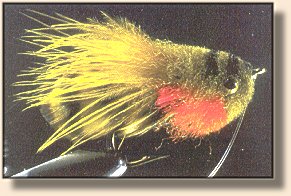A friend once told me that he didn't think largemouth bass ate
many bluegills. "Why not?" I asked. "They're plentiful, and just one
makes a big meal."
He replied with a single word: "spine."
I understood - bluegills have stiff, pointed spines
mixed into their fins. Anyone who has caught a few
bluegills has been poked by them. I imagined eating
a whole, spiny, thrashing bluegill and my mouth hurt.
Made perfect sense, so I wrote bluegills off my list as
bass food. But I mentally logged my usual trace of
skepticism.
The following summer I was on a tiny bass-bluegill pond, one
oval acre behind an earthen dam. I'd never found a decent
bass in it, but I'd found some good bluegills. For some
reason the fish were down. I put up a pan-fish fly called
the SMP, let its weighted eyes carry it down, and then worked
it slowly just off the bottom. Every couple of casts I'd feel
the slow resistance of pond weed or the thump of a bluegill.
Then the sun began to set, leaving a rim of soft yellow light
along the hilltops. Now the bluegills were up; the pond
dimpled with their feeding. So I put up a tiny Skip's
Fusion Bug and cast it across the open water near the dam to
the edge of the weeds. I'd let it lie quiet, then make it
dive and float back up. I caught bluegill after bluegill,
mostly small but with the occasional good one to keep things
interesting.
When the hilltops were gone and the pond was black, a good
bluegill swirled on my bug and then panicked at the hook's bite.
Then came an absurdly big swirl and a heavy throb down the
rod - a big bass had taken my bluegill. I struck hard,
praying the bluegill was lightly hooked and that the fly
would snap from it into the bass. The throbbing continued
for a moment; then the bluegill popped out of the water and
skimmed flat-sided across it, the little bug firmly pinned
to its jaw.
I knew then that despite the spines, bass eat bluegills. In
retrospect, it's hard to imagine bass doing well without
eating things that defend themselves. Bass eat crayfish,
which pinch; dragonfly nymphs, which bite; and likely all
kinds of spiny, biting, pinching things.
So Jimmy Nix, in creating a bluegill imitation, was right,
and my friend and I were wrong.

After I started looking around for a bluegill imitation,
and then found Jimmy's Shineabou Sunfish. I had seen plenty
of flies with feathers lashed atop a body by a rib, Matuka
style, but I'd never seen the effect doubled - feathers both
atop and beneath the body - and was impressed at how well
this suggested the flattened bulge of a bluegill.
But the Shineabou Sunfish's lead eyes were mounted atop the
shank, and that concerned me. On the Clouser Deep Minnow
such an arrangement inverts the hook, which is fine because
the Clouser is designed for it, but I couldn't imagine an
upside-down bluegill looking plausible to a bass. So I tied
a few Jimmy's way; them I tied a few with the lead eyes
beneath the shank. Tied my way, the flies looked
wrong - the eyes were too low. Then I trimmed the tops
of their heads down and they looked fine.
In the end, Jimmy's way worked fine. All that steel in the
wide-gap bass-bug hook keeps everything upright, just as
long as the retrieve isn't too quick.
So, again, Jimmy was right and I was wrong. I saw a pattern
in all this and began to take Jimmy more seriously.
I still tie my Shineabous with eyes beneath the shank. I
think I can retrieve them faster that way, without concern that
the fly will turn over. But my whole approach to fly fishing is
neurotic, so perhaps this eye-business is just more of that.
I have found that, regardless of how the eyes are set, some
Shineabous turn on their sides, especially at a fast retrieve.
The best defense I've found is to make sure the eyes are centered,
their weight evenly distributed to the sides. But maybe they
are supposed to turn; maybe this makes them look vulnerable. I
hesitate to question Jimmy's design - a guy can get tired of
being wrong. The tying instruction for the Shineabou describe,
as usual, the way I tie it. ~ Skip Morris
For the recipe and tying instructions for the Shineabou Sunfish,
click HERE.
Credits: From Fly Tying and Fishing for Panfish & Bass
published by Frank Amato Publications. We greatly appreciate use permission.
|

